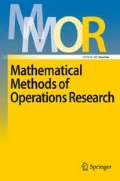Abstract
This paper proposes an unconstrained dual approach and an efficient algorithm for solving Karmarkar-type linear programming problems. Conventional barrier functions are incorporated as a perturbation term in the derivation of the associated duality theory. An optimal solution of the original linear program can be obtained by solving a sequence of unconstrained concave programs, or be approximated by solving one such dual program with a sufficiently small perturbation parameter. A globally convergent curved-search algorithm with a quadratic rate of convergence is designed for this purpose. Based on our testing results, we find that the computational procedure is very efficient and can be a viable approach for solving linear programming problems.
Similar content being viewed by others
References
Apostol TM (1957) Mathematical analysis. Addison-Wesley Reading Massachusetts
Bazaraa MS, Shetty CM (1979) Nonlinear programming — theory and algorithms. Wiley New York
Barnes ER (1986) A variation of karmarkar's algorithm for solving linear programming problems. Mathematical Programming 36:174–182
Ben-Tal A, Melman A, Zowe J (1990) Curved search methods for unconstrained optimization. Optimization 21 5:669–695
Bertsekas DP (1982) Constrained optimization and lagrange multiplier methods. Academic Press New York
Dennis JE, Schnabel RB (1983) Numerical methods for unconstrained optimization and nonlinear equations. Prentice Hall Englewood Cliffs New Jersey
Fang S-C (1990/1992) A new unconstrained convex programming view to linear programming. North Carolina State University Operations Research Report 243, Zeischrift fur Operations Research 36:149–161
Fang S-C, Puthenpura S (1993) Linear optimization and extensions. Prentice Hall Englewood Cliffs New Jersey
Fang S-C, Tsao H-SJ (1993) Linear programming with entropic perturbation. Zeitschrift fur Operations Research 37:171–186
Fang S-C, Tsao H-SJ (1993) An unconstrained convex programming approach to solving convex quadratic programming problems. Optimization 27:235–243
Fiacco AV, McCormick GP (1968) Nonlinear programming: Sequential unconstrained minimization Techniques. Wiley New York
Gill PE, Murray W, Saunders M, Tomlin TA, Wright MH (1986) On projected newton barriers for linear programming and an equivalence to karmarkar's projective method. Mathematical Programming 36:183–209
Karmarkar N (1984) A new polynomial time algorithm for linear programming. Combinatorica 4:373–395
Luenberger DG (1984) Linear and nonlinear programming, 2nd Edition. Addison-Wesley Reading Massachusetts
Mangasarian OL (1983) Least-norm linear programming solution as an unconstrained minimization problem. Journal of Mathematical Analysis and Applications 92:240–251
Minoux M (1986) Mathematical programming theory and algorithms. John Wiley & Sons New York
Rajasekera JR, Fang SC (1991) On the convex programming approach to linear programming. Operations Research Letters 10:309–312
Rockaffelar RT (1970) Convex analysis. Princeton University Press Princeton New Jersey
Tseng P (1995) Linearly-constrained convex programming as unconstrained differential concave programming. To appear in Journal of Optimization Theory and Applications, Vol 85
Vanderbei RJ, Meketon MS, Freedman BA (1986) A modification of karmarkar's linear programming algorithm. Algorithmica 1:395–407
Author information
Authors and Affiliations
Rights and permissions
About this article
Cite this article
Jacob Tsao, H.S., Fang, SC. An unconstrained dual approach to solving Karmarkar-type linear programs using conventional barrier functions. ZOR - Methods and Models of Operations Research 42, 325–343 (1995). https://doi.org/10.1007/BF01432508
Received:
Revised:
Issue Date:
DOI: https://doi.org/10.1007/BF01432508




